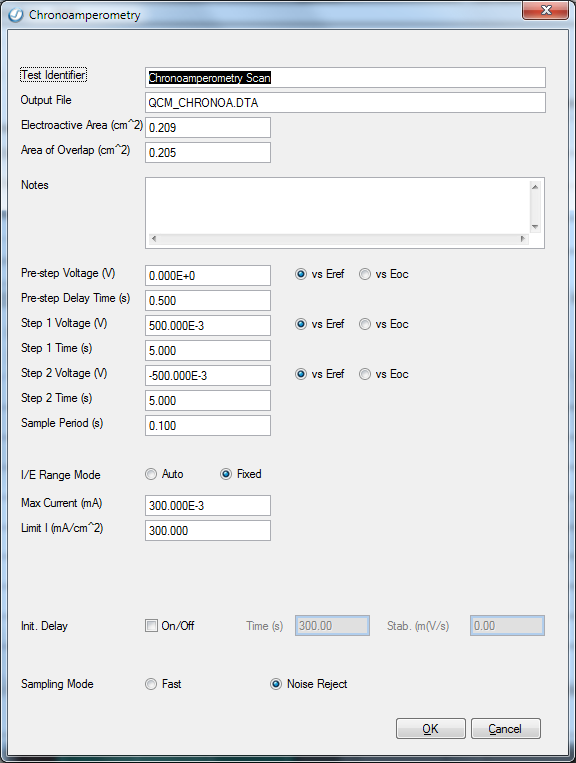

|
See Test Identifier in the Common Potentiostat Setup Parameters page. |
||
|
See Output File in the Common Potentiostat Setup Parameters page. |
||
|
See Electroactive Area in the Common Potentiostat Setup Parameters page. |
||
|
See Area of Overlap in the Common Potentiostat Setup Parameters page. |
||
|
See Notes in the Common Potentiostat Setup Parameters page. |
||
| Pre-step Voltage (V) | Choose between the vs Eref radio button (reference electrode) and the vs Eoc radio button (open circuit). | |
|
The Pre-step Delay Time is the time for which a Pre-step Voltage is applied. It is shown as negative time on the real-time display. |
||
|
The voltage is typically 0 and the time is usually quite short. |
||
|
The Step 1 Time is the time for which the Step 1 Voltage is applied to the cell. Units are seconds, and the value is greater than zero. The maximum time is based on the Sample Period setting, because the maximum number of points is 32 000. |
||
|
The Step 1 Voltage is the first voltage to be applied to the cell. Units are volts and can be versus Reference or versus open-circuit potential. The Step 1 Voltage is applied for the Step 1 Time. |
Choose between the vs Eref radio button (reference electrode) and the vs Eoc radio button (open circuit). | |
|
The Step 2 Time is the time for which the Step 2 Voltage is applied to the cell. Units are seconds and the value is greater than zero. The maximum time is based on the Sample Period setting, because the maximum number of points is 32000. |
||
|
The Step 2 Voltage is the second voltage to be applied to the cell. Units are volts and can be versus Reference or versus open-circuit potential. The Step 2 Voltage is applied for the Step 2 Time. |
Choose between the vs Eref radio button (reference electrode) and the vs Eoc radio button (open circuit). | |
|
The Sample Period parameter determines the spacing between data points. The units are seconds. The shortest Sample Period we recommend is 1.0 ms. The longest Sample Period allowed is 600 seconds. For speeds faster than 1.0 ms, the display of the real-time data is delayed. This helps insure that your system is able to keep up with the fast data-acquisition rate. |
||
|
See I/E Range Mode in the Common Potentiostat Setup Parameters page. |
||
|
See Max Current in the Common Potentiostat Setup Parameters page. |
||
|
The Limit I parameter is used to prevent excessive cell current. If the absolute value of the current exceeds the Limit I, the data acquisition in the current step ends prematurely. Exceeding the Limit I during the first step causes the experiment to skip to the second step. Exceeding the limit during the second step causes the experiment to terminate. |
||
| Sampling Mode |
Sampling Mode defines whether or not the potentiostat oversamples and averages during acquisition. These choices are only available on the Reference™ family instruments. |
|
| Init. Delay | See Init. Delay in the Common Potentiostat Setup Parameters page. |